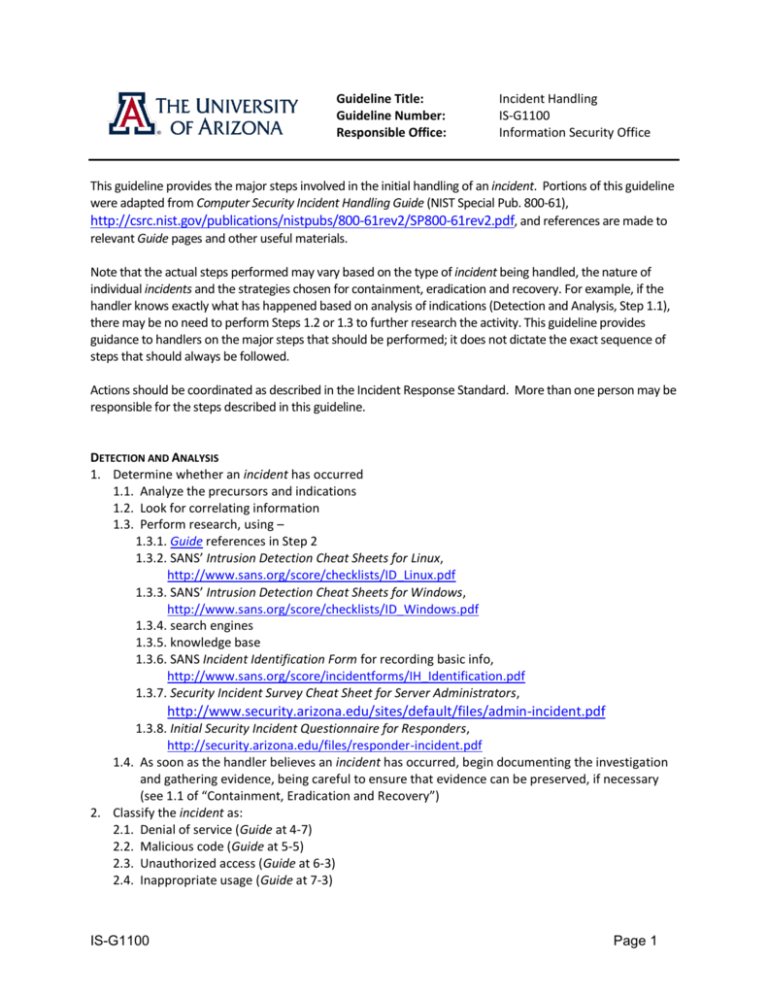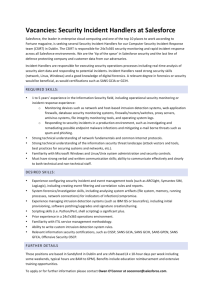Incident Handling - UA Information Security
advertisement

Guideline Title: Guideline Number: Responsible Office: Incident Handling IS-G1100 Information Security Office This guideline provides the major steps involved in the initial handling of an incident. Portions of this guideline were adapted from Computer Security Incident Handling Guide (NIST Special Pub. 800-61), http://csrc.nist.gov/publications/nistpubs/800-61rev2/SP800-61rev2.pdf, and references are made to relevant Guide pages and other useful materials. Note that the actual steps performed may vary based on the type of incident being handled, the nature of individual incidents and the strategies chosen for containment, eradication and recovery. For example, if the handler knows exactly what has happened based on analysis of indications (Detection and Analysis, Step 1.1), there may be no need to perform Steps 1.2 or 1.3 to further research the activity. This guideline provides guidance to handlers on the major steps that should be performed; it does not dictate the exact sequence of steps that should always be followed. Actions should be coordinated as described in the Incident Response Standard. More than one person may be responsible for the steps described in this guideline. DETECTION AND ANALYSIS 1. Determine whether an incident has occurred 1.1. Analyze the precursors and indications 1.2. Look for correlating information 1.3. Perform research, using – 1.3.1. Guide references in Step 2 1.3.2. SANS’ Intrusion Detection Cheat Sheets for Linux, http://www.sans.org/score/checklists/ID_Linux.pdf 1.3.3. SANS’ Intrusion Detection Cheat Sheets for Windows, http://www.sans.org/score/checklists/ID_Windows.pdf 1.3.4. search engines 1.3.5. knowledge base 1.3.6. SANS Incident Identification Form for recording basic info, http://www.sans.org/score/incidentforms/IH_Identification.pdf 1.3.7. Security Incident Survey Cheat Sheet for Server Administrators, http://www.security.arizona.edu/sites/default/files/admin-incident.pdf 1.3.8. Initial Security Incident Questionnaire for Responders, http://security.arizona.edu/files/responder-incident.pdf 1.4. As soon as the handler believes an incident has occurred, begin documenting the investigation and gathering evidence, being careful to ensure that evidence can be preserved, if necessary (see 1.1 of “Containment, Eradication and Recovery”) 2. Classify the incident as: 2.1. Denial of service (Guide at 4-7) 2.2. Malicious code (Guide at 5-5) 2.3. Unauthorized access (Guide at 6-3) 2.4. Inappropriate usage (Guide at 7-3) IS-G1100 Page 1 2.5. Multiple components (Guide at 8-1) 2.6. Generic, if none of the above (Guide at 3-5) 3. Identify which resources have been affected and forecast which resources will be affected 4. Estimate the current and potential technical effect of the incident 5. Prioritize handling the incident based on the operational impact REPORTING 1. Report the incident to the appropriate internal personnel and external organizations, as provided in the Incident Response Standard 2. If reporting to the UISO, University Information Technology Services, the HIPAA Privacy Officer, FSO – Bursar’s Department Services and/or law enforcement is required, coordinate remaining steps with personnel from such organizations Resource: Incident Response Standard (IS-S1100) CONTAINMENT, ERADICATION AND RECOVERY 1. Generic Incidents 1.1. Acquire, preserve, secure and document evidence 1.2. Contain the evidence 1.3. Eradicate the incident 1.4. Identify and mitigate all vulnerabilities that were exploited 1.5. Remove malicious code, inappropriate materials, and other components 1.6. Recover from the incident 1.7. Return affected systems to an operationally ready state 1.8. Confirm that the affected systems are functioning normally 1.9. If necessary, implement additional monitoring to look for future related activity Resources: Guide at 3-17 (see link in first paragraph) 2. Denial of Service Incidents 2.1. Acquire, preserve, secure, and document evidence 2.2. Contain the incident—halt the denial of service if it has not already stopped 2.2.1.Identify and mitigate all vulnerabilities that were used 2.2.2.If not yet contained, implement filtering based on the characteristics of the attack, if feasible 2.2.3.If not yet contained, contact the Internet service provider (UITS for most units) for assistance in filtering the attack 2.2.4.If not yet contained, relocate the target 2.3 Eradicate the incident; if Step 2.2.1 was not performed, identify and mitigate all vulnerabilities that were used 2.4 Recover from the incident 2.4.1 Return affected systems to an operationally ready state 2.4.2 Confirm that the affected systems are functioning normally IS-G1100 Page 2 2.4.3 If necessary and feasible, implement additional monitoring to look for future related activity 3. Malicious Code Incidents 3.1. Contain the incident 3.1.1.Identify infected systems 3.1.2.Disconnect infected systems from the network 3.1.3.Mitigate vulnerabilities that were exploited by the malicious code 3.1.4.If necessary, block the transmission mechanisms for the malicious code 3.2. Eradicate the incident 3.3. Disinfect, quarantine, delete, and replace infected files 3.4. Mitigate the exploited vulnerabilities for other hosts within the unit and/or the university 3.5. Recover from the incident 3.5.1.Confirm that the affected systems are functioning normally Resources: UITS Security Operations web site, http://uits.arizona.edu/services/secops 4. Unauthorized Access Incidents 4.1. Perform an initial containment of the incident 4.2. Acquire, preserve, secure, and document evidence 4.3. Confirm the containment of the incident 4.3.1.Further analyze the incident and determine if containment was sufficient (including checking other systems for signs of intrusion) 4.3.2.Implement additional containment measures if necessary 4.4. Eradicate the incident 4.4.1.Identify and mitigate all vulnerabilities that were exploited 4.4.2.Remove components of the incident from systems 4.5. Recover from the incident 4.5.1.Return affected systems to an operationally ready state 4.5.2.Confirm that the affected systems are functioning normally 4.5.3.If necessary, implement additional monitoring to look for future related activity Resources: Guide at 6-5 (see link in first paragraph) SANS, Intrusion Detection Cheat Sheets for Linux, http://www.sans.org/score/checklists/ID_Linux.pdf SANS, Intrusion Detection Cheat Sheets for Windows, http://www.sans.org/score/checklists/ID_Windows.pdf CERT, Steps for Recovering from a UNIX or NT System Compromise, http://www.cert.org/tech_tips/root_compromise.html 5. Inappropriate Usage Incidents 5.1. Acquire, preserve, secure, and document evidence 5.2. If necessary, contain and eradicate the incident (e.g., remove inappropriate materials) Resource: IS-G1100 Page 3 Guide at 7-5 (see link in first paragraph) 6. Multiple Component Incidents 6.1. Follow the Containment, Eradication, and Recovery steps for each component, based on the results of Detection and Analysis Resource: Guide at 8-2 (see link in first paragraph) Post Incident Activity 1. Create a follow-up report 2. Hold a lessons-learned meeting (Guide at 3-22) All italicized terms used in this guideline are defined in the Information Security Terms Guideline (ISG100). Related Guidance Information Security Policy (IS-100) Information Security Terms Guideline (IS-G100) Exceptions Procedure (IS-P100) Incident Response Standard (IS-S1100) Incident Response Plan (IS-P1100) Computer Security Incident Handling Guide (NIST Special Pub. 800-61) http://csrc.nist.gov/publications/nistpubs/800-61/sp800-61.pdf SANS, Intrusion Detection Cheat Sheets for Linux, http://www.sans.org/score/checklists/ID_Linux.pdf SANS, Intrusion Detection Cheat Sheets for Windows, http://www.sans.org/score/checklists/ID_Windows.pdf SANS, Incident Identification Form, http://www.sans.org/score/incidentforms/IH_Identification.pdf CERT, Steps for Recovering from a UNIX or NT System Compromise, http://www.cert.org/tech_tips/winUNIX-system_compromise.html Revision History Initial Draft 11/8/08 UA-ISAC Review 4/2/09 Effective Date 7/1/09 IS-G1100 Page 4








